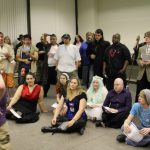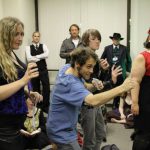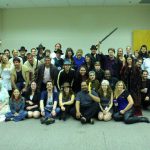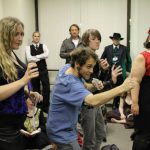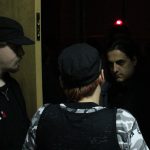My GenCon wrap-up post has been delayed once more to bring you this late breaking bulletin:
It’s still not okay to cosplay as a Nazi.
In case you forgot. Just checking in.
You’d think a girl wouldn’t have to put this up a second year. I had a post up last year about how it was impossible to miss the presence of Nazi memorabilia being sold at GenCon. How there were cosplayers who thought it was cool to walk down the street wearing their Nazi gear. Over the year that issue remained relevant as such instances of Nazi cosplay and memorabilia being sold were reported at other conventions, such as NYCC. Apparently, it wasn’t just a GenCon thing.

Last year’s article then got reposted in A.A. George’s post about race issues at GenCon and so the issue has come up with a huge number of people talking about it. And y’know what I’m hearing a lot of? Apologizing. I’m hearing apologizing and excuses made FOR THE PEOPLE WHO WANT TO WEAR NAZI GEAR. And not in the context of, y’know, historical reenactment where they’re going to get punched in the face by the Allies, like Captain America did to Hitler.
Some of these apologies are in two posts that have gone up in response to A.A. George’s article, found here and here. I’ll save you reading through the entire things because, frankly, they’re not all that impressive to begin with. They rely on Fisking their way thru George’s piece, going line by line to dissect terms rather than actually addressing the issue with courtesy and respect. So I’ll hone in on the salient points to THIS conversation, namely where they talk about my article.
The first article lies here and here’s a screenshot. The quoted part is the original article by A.A. George while the second half is the opinion of the article’s author:
No, but pinup girls in Nazi uniforms are. And last year there was Nazi military stuff. This year at the same booth there was vintage anti-Japanese propaganda posters. Are these really necessary to make games about bad guys at cons? Are these somehow necessary to display Nazis as the villain of some pieces? Or are they a contextless representation of racist crap, being sold to people right across from where folks are buying cool t-shirts? It’s someone using the GenCon space to financially profit from selling hateful memorabilia with ZERO context to a game. The same would be cosplayers who are walking around the con. There being zero context for their costumes in some cases, we’re looking at folks doing their shopping or playing their Pathfinder games, and looking up to see a dude sporting the old ‘fetishized militaria’ costumes.
That’s my response to THAT article. A conversation then came up on Google+ where someone defended the very fact that making Nazis a taboo subject would… create Nazis. Hang on for a ride here, folks, this is what we’re up to: (Names filed off this quote for anonymity of the poster)
Anytime you make it taboo, you plump it up, invigorate it, make it more virile. Anytime you make it off-limits, you make it off-limits to mock, you make it off-limits to parody, you make it off-limits to deconstruct, to integrate, to drain the power from it into a wider form of expression. Every time you say “no Nazi imagery is acceptable,” you reinforce the idea that just the appearance of a thing, just the visual stimulation of a thing, is so powerful that rational people must reject it for fear that they become tainted merely by association.
Congratulations, you’ve just built your own enemy and fêted on your own blood. You’re kind of an idiot.
There are very few more dangerous statements, ideas, or strings of expressions than, “that part of history is too close to home for freedom of expression.” Freedom of expression is how you contextualize history. Freedom of expression is how you get beyond history. Freedom of expression is how you make new history. So long as Austria and Germany have strict and constant vigilance against the threat presented by Nazis, they will always have Nazis. They build Nazis. They make Nazis. They have least themselves to the very idea that the Nazi has power over them, so much so that the very whiff of National Socialism is outside the purview of what can be discussed or represented.
You want Nazis? Because that’s how you get Nazis.”
First, whoa there tiger. You create Nazis by not allowing people to be Nazis? No, last I checked, people become Nazis because they choose to personally associate with the symbols, beliefs, and ideas of a hate-based party. Countries that have strict laws against the presence of Nazis, neo-Nazis, and fascists of the like are, last I checked, trying to check the creation of hate groups within their country. Which in my eyes is not a bad thing.
“But wait! What about freedom of expression! If we’re not careful, soon we’ll be treating Nazis like You-Know-Who in Harry Potter! We’ll be censored! Oh no!” Oh we could do a dance about what freedom of expression really means, and the fact that freedom of expression is in fact NOT universal no matter what we think (cannot shout fire in a crowded room, ect.) and also does not take away from the fact that when you express, you must be responsible and accountable for the repercussions of said expression. Which includes people saying you’re offensive and even potentially harmful at an event when wearing and exhibiting Nazi paraphernalia.
What’s so sad is I agree on one point: freedom of expression allows people to address difficult subject matter. It’s what makes us able to explore it. But there is such a thing as exploring it in a manner that is respectful for the nightmare that it caused. It’s all about context, as is so many things. And where, for example, games like Achtung! Cthulhu or Weird World War engage with Nazi material, as does many games that touch upon WWII, it’s the context of “UR MER GERD, NAZIS ER COOL!” that is blatantly problematic. This isn’t a question of white-washing them out of history, of a chance of us forgetting that Nazis are one of the worst evils around. I don’t feel that by saying that you can’t cosplay as a character that we’re risking future generations not knowing about the evils of Nazi Europe. It’s about creating a space in which people don’t walk into a convention hall, or past a booth, and overhear some dudes going “wow, look at this cool Nazi gear! It’ll look great in my collection!”
Which is exactly the context by which I ran into that booth the year before. I went into that booth to buy patches for my zombie-fighting LARP armor and ran smack into Nazi imagery, paraphernalia, and a couple of guys talking about adding some of it to ‘their collection.’ I fled that booth as fast as my legs would go. I wanted to be nowhere near it. Too bad it was right across from the booth of a friend of mine. I had to pass it every damn time I came to visit them. This year? It was right across from a booth I normally visit to buy t-shirts. I didn’t go anywhere near that t-shirt booth or any of those around it. That’s my business gone, my dollars not spent at any of the booths in the vicinity of the nazi gear. And maybe that’s just me. But that’s a financial repercussion: I voted with my wheelchair wheels and got the hell away from that booth for the second uncomfortable year.
This conversation, having been brought up by the Tor.com article, has highlighted some nasty, uncomfortable parts of the gaming world that seemingly think it’s benign to wear these things, to display them. That some sort of freedom of expression will be indelibly damaged by a rule against Nazi cosplay and the selling of Nazi paraphernalia at conventions. Sure, you have the right to wear these things thru freedom of expression. But there’s a big difference between you CAN wear something and you SHOULD.
Once again, I reiterate a previous stance I have: gaming spaces are shared spaces. And the impact displaying hate-associated imagery in that larger convention space, especially without the context of ‘Nazis-as-despicable-villains’ is harmful to those for whom historical Nazis are a personal nightmare. The display of such callous disregard for the feelings of others on the matter in the face of “BUT I WANNA COSPLAY!” is crude and tasteless at best and harmful and cruel at worst.
And you know what’s the worst part? I said all of this last year! Most of this post is almost verbatim what I said in last year’s post after engaging with the booth and first their sexist stuff and then their Nazi gear. This comes up again, and again. And again. And what worries me is that it isn’t going to be addressed. People who are afraid of their precious ‘freedom of expression’ being violated by so-called ‘social justice warriors’ are going to scream at the heavens when I mention that contextless Nazi cosplay and paraphernalia for sale is uncomfortable. They’ll slap that old “Oh this is just those crazy Social Justice Warriors” again on it and ignore.
Y’know what? You can’t say that you’re all about engaging with arguments when you ignore their content for the sake of saying that it’s just something brought up by social justice warriors. I loathe that term so much. It is the most reductive, diversionary tactic by those who are too lazy to actually engage with issues and want to hand wave away the credibility of anyone bringing these topics up. But for those who want to avoid talking about issues, who just want to have things their way and not consider the comfort of others, then the answer will always be “Get a thicker skin.”
Well my skin’s pretty thick. That’s how I got into this fight in the first place. To speak up for something that I find repugnant against a cacophony of apologists and excusers. And I’ll bring it up again, next year, if the topic comes up again. Which, considering our luck so far, it almost assuredly will.









